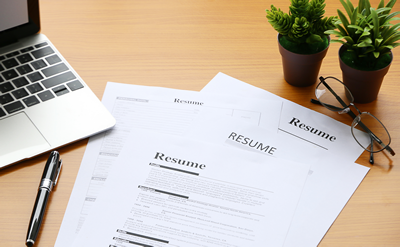Follow These Key Resume Tips
"A good resume can help you land a job in the entertainment industry. A bad one might never be seen by a human."
The above quote might sound like a line from a heist movie, but your resume has to get past two obstacles before you’re considered:
- The Computer
- The Recruiter
Here’s how to put together a resume that the computer will like and the recruiter will read so you have the best chance of getting the industry job you want.
Getting your resume past the computer
You may have never heard of an ATS, but it probably stands between you and an interview. Applicant Tracking Systems (aka 'ATS') are software programs that take your submitted data, organize it, search it, and store it. These systems are used by most companies, big studios and small production studios alike, to help initially screen the best candidates for a job.
If the ATS has trouble reading your resume — or if it doesn’t find the right info — your resume probably won’t move forward.
How to format your resume

Sad truth? Boring is best. While you might want to use eye-catching fonts and creative formatting techniques to stand out, don’t. The sophistication of ATS systems varies widely and some can’t recognize anything beyond very straightforward text.
- Only use safe fonts like Arial, Times New Roman, or Courier New
- Don’t use columns. Some ATS systems text from top left to bottom right, ignoring any columns
- No tables, no graphics - computer systems have trouble with those as well
- Avoid special characters like emojis
- Save your resume in .docx or .pdf only. Not Apple Pages or some other word processor format
Use sections
When extracting data, the software needs help understanding what goes where. Use sections with headings to make things clear. After your contact info at the top, include:
- Work experience
- Education
- Experience
- Awards or Achievements
- Personal Interests
We’ll talk about what to put in those sections, and which order to put them in later. But notice that “objective” isn’t on the list. Everyone knows you’re looking to break into or advance your career in the entertainment industry. That’s why you sent in your resume.
Include keywords

While it might save time to have a single gold-star resume you send to every opening you’re interested in, adjusting your wording each time will help get you past the ATS robots. Applicant software is often trained to search for keywords that relate to the job. Luckily, finding those keywords isn’t tricky — they’re often the same ones that show up in the job description under “requirements” and “responsibilities.”
Find keywords that match your experience or training then find the right places within your resume to include them. Synonyms and variations on the wording will most likely work, but if you can find a way to include the exact words (without sounding like you just cut and pasted) then go for it.
Getting your resume past the recruiter
After convincing the computer you’d be a good fit, you have to convince a human. Common advice says you’ve got between five and ten seconds to impress someone looking at your resume. That means a few rules apply.
Put your best stuff first
If your last job was a similar role to the one you’re applying for, put your work history up at the top. If you’ve just graduated from film school and don’t have a lot of experience, put your education first. If you haven’t yet done the job but have relevant skills, prioritize your applicable skills.
Another great way to catch someone’s attention and demonstrate you’re a fit is with a professional summary section. In one or two sentences, sum up what you bring to the table - put this just below your Contact info. This isn’t the place to display your knack for jargon and insider speak. Just say what you actually do and how you do it. For example:
- "Detail-oriented and proactive assistant with a flair for event planning."
- "Personable and collaborative camera operator with broad experience using high definition video hardware and software."
- "Highly communicative dailies technician with deep knowledge of television post-production processes."
Be specific
Even if you’ve been at this for years, your resume should fit on one page. That means you have to maximize every word you put down. If a job or a task you performed isn’t relevant to the job at hand, leave it out. Instead of using fancy or fluff words to give a broad overview of your role, use concrete examples.
Include results: If you organized a screening for 200 people, say so. If the student film you produced won an award, name it. Like the advice on keywords, your resume will benefit if you include the tasks you performed and the skills you possess that best match the job description.
Personalize it
You might be totally qualified for the job — so might fifty other people. A small section at the bottom of your resume is a good place to include any unique interests you may have. The person doing the hiring might also be into backpacking or true crime documentaries. You never know what little thing could tip the scales in your favor.
Proofread. Then proofread again.
No one wants to miss out on an opportunity due to a typo, but recruiters are looking for any reason to narrow the field. An unedited resume looks sloppy, like the applicant didn’t care.
Don't Go It Alone
After you go over your resume with a fine-tooth comb, find 3 other people who can review your resume and give you honest feedback. Sorry, but Mom probably isn't the best person for this job. Ideally, look for someone in a hiring role for the type of job you are looking for or someone who works in HR. They’ll be able to catch anything you missed, leaving you with the perfect resume to land that job.
